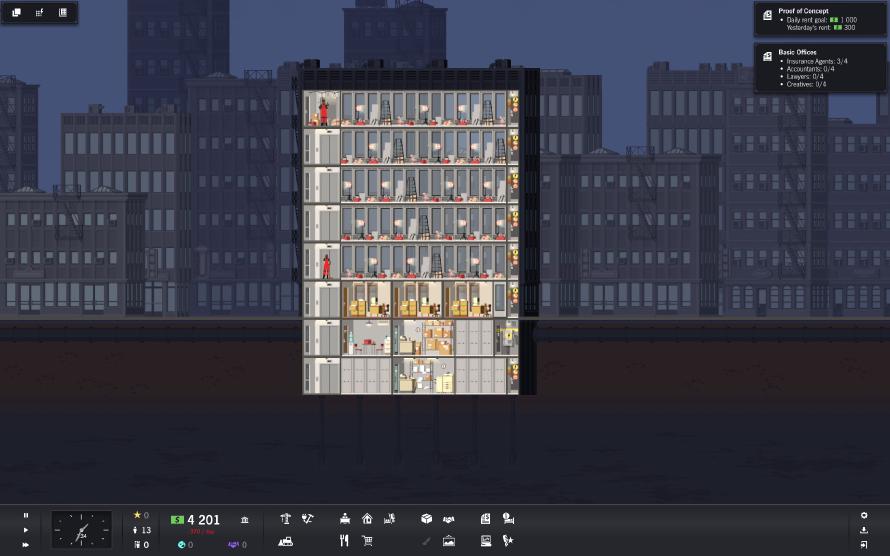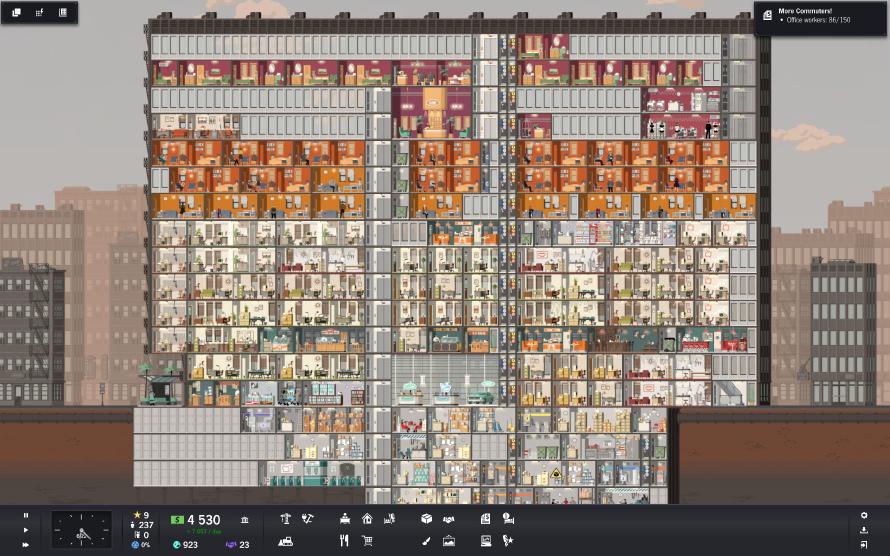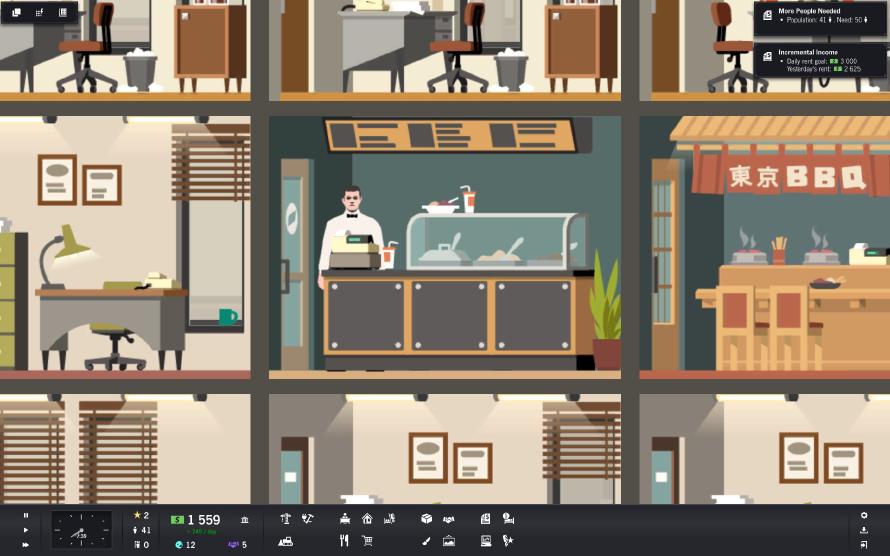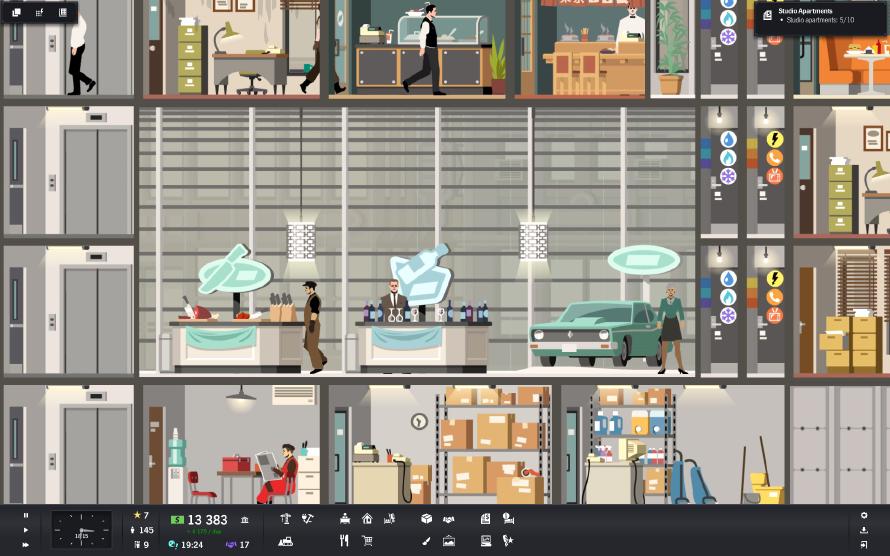Project Highrise
If you’ve been around for a while, you might be familiar with the 1994 simulation title SimTower. The Japanese game, which was published by the once great Maxis outside of Japan, allowed the player to construct and manage a modern, multi-use skyscraper. Even though I never really got the hang of it1, I loved SimTower. When Chicago based developer SomaSim released Project Highrise back in 2016, I got properly excited. The game behaved like SimTower’s older brother, but with an even more detailed simulation than its spiritual predecessor offered.
But I didn’t put on my hardhat, and entered the construction business immediately when Project Highrise was released. I had too much else on my plate, and the game’s art style put me off a little, to be honest. But when Project Highrise, and all its DLC appeared on sale last week, I couldn’t resist the temptation anymore. It was time to see if this was a skyscraper construction and management sim I could actually master.
Another Brick in the Wall
A state-of-the-art tower needs a lot of things to work property. While not every single one of the building options is available to you when you start a new game, there’s still plenty for you to do. You can build offices, apartments, restaurants, and stores from the get-go. The offices, restaurants, and stores are leased to companies that want to try to make a living in your thriving tower, while the apartments are rented to individuals who want to wake up with a view. Hotel building options also become available as the game progresses.
Tenants will have different needs you have to cover. Legal firms, for example, will only rent office space in your tower if you can provide copy services. Video game companies need a cable TV connection, and medical professionals will not settle in your tower unless it has a drug store. As you play, more people will hear about your tower, and your prestige increases. When this happens, more building options will become available, like larger apartments, and office spaces. But the companies that you can lease the extended space to, have even more intricate needs you have to cover before they want to move in.

The Frankentower
Project Highrise construction is based on tiles, so say hello to any OCD you might have. Everything you build in the game will require at least one tile. As a cruel joke, SomaSim has made sure that the size of things doesn’t scale naturally when they grow. Case-in-point: A small office space takes up 4 tiles. It would be natural to assume, then, that a medium office space is 8 tiles in size. But, no. It’s 10 tiles. This makes it impossible to replace two small offices with a medium one without either thinking ahead, and wasting a lot of space initially, or to renovate, and relocate like a madman.
The result of this was that my first tower looked like a massive mess. “Zen” and “feng shui” where not words uttered by the visitors, as they entered the Frankentower. It looked like something thrown together by a wasted monkey at an after-party. “You want to get to Top Notch Records, you say? Well, take the elevator up to the 10th floor, then the the stairs down to the 3rd, go past the hot dog stand, take a left by trash cans, then take the service elevator back up to the 15th floor, and it’ll be on your left. Easy as pie.”

Not a Hard Nut to Crack
The tenants of Frankentower got their needs fulfilled. They got their coffee, breakfast, lunch, and dinner. The tower housed enough stores, and services that I’m sure most of the tenants never needed to leave the building. Keeping the game running at full speed, I got more money coming in each day than I could possibly use, and the challenge faded. A game that doesn’t challenge you properly, is too much of a sandbox for me. A few random events, like an earthquake, tried to throw a monkey wrench into the works, but the random events didn’t really impact the tower, or the money press in the basement.
I should probably note that I played on easy difficulty. On that difficulty, you start with a good amount of money. The economy is solid, and tenants easy to find. On hard difficulties, you start with less money, costs are higher, and unhappy tenants will move out faster. This ought to make the game more challenging, but to me it sounds like it would only take a bit longer to make an overwhelming daily profit.
More random, and more devastating events could perhaps make the game more challenging. Perhaps an idea for a new DLC, SomaSim?

Final Thoughts
Project Highrise makes a good first impression. SomaSim’s attention to detail is impressive, and I’m pretty sure they’ve had a lot of fun when making their game. It’s obvious that the developer put a lot of effort into the game. Despite being only a 5 man team, Project Highrise comes across as pretty solid. The UI could need another iteration, though. There is a lot of stuff to build, which means a larger number of menus, some of which are not totally trivial to understand. Even a few hours into the game, I find myself clicking on the wrong menu when I’m looking for a particular thing to build.
There is a lot of focus on the esthetics, and many ways you can decorate your tower to make it look great. I didn’t spend much time on that, mostly because the poor Frankentower was a lost cause aesthetically from very early on. If you enjoy spending hours tinkering with wallpapers, lighting, and potted plants, that’s something you’ll find a lot of in the game. Even though Project Highrise simulates a lot of events, and agents, it does not need a lot of hardware. You’ll do just fine with a Intel Core i5 processors, and an a basic 1GB integrated graphics card.
Will I return to Project Highrise? To be honest, I don’t think so. I’ll keep the game installed on Steam so that I get any new updates that SomaSim might release. But I doubt I’ll put many more hours into the game. There are other games I’d rather spend my precious spare time on.

This review is based 7 hours of gameplay with the 1.5.12 (V20180416) version of Project Highrise with the following DLC installed: Las Vegas, Miami Malls, Tokyo Towers, and London Life.
Feedback
This post has no feedback yet.
Do you have any thoughts you want to share? A question, maybe? Or is something in this post just plainly wrong? Then please send an e-mail to vegard at vegard dot net with your input. You can also use any of the other points of contact listed on the About page.